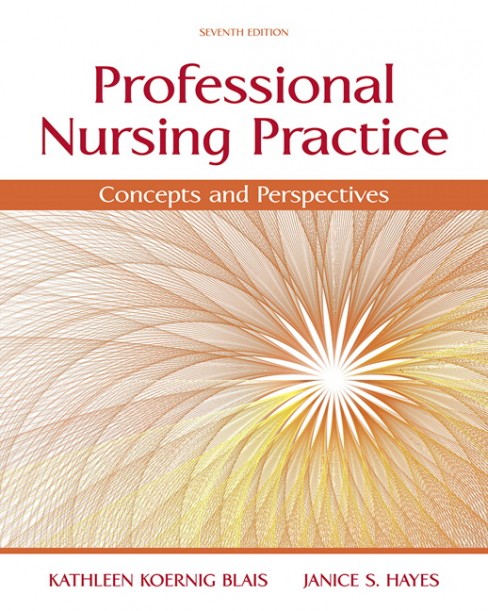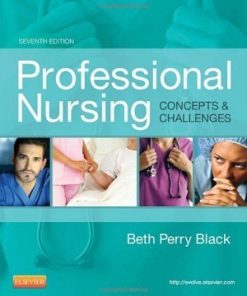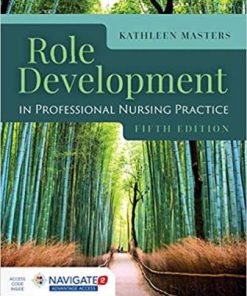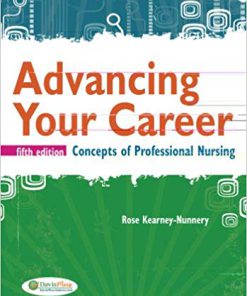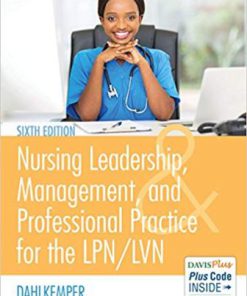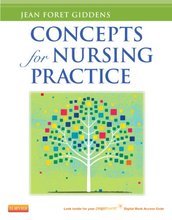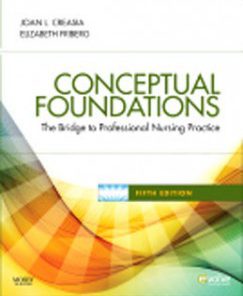Professional Nursing Practice Concepts Perspectives 7th Blais Hayes Test Bank
$35.00 Original price was: $35.00.$26.50Current price is: $26.50.
Professional Nursing Practice Concepts Perspectives 7th Blais Hayes Test Bank
Instant download Professional Nursing Practice Concepts Perspectives 7th Blais Hayes Test Bank pdf docx epub after payment.
== SAMPLE ==
Blais/Hayes, Test Item File for Professional Nursing Practice: Concepts and Perspectives, 7e
Chapter 2: Socialization to Professional Nursing Roles
Question 1
Which organization published a 1965 position paper that identified associate degree nurses as “technical nurses”?
1. The American Medical Association
2. The American Nurses Association
3. The American Association of Colleges of Nursing
4. The National League for Nursing
Correct Answer: 2
Rationale: In 1965, the American Nurses Association published a position paper on education of nurses that differentiated nurses with baccalaureate degrees and nurses with associate degrees as professional and technical nurses. The other organizations listed did not publish such papers.
Cognitive Level: Remembering
Client Need: Safe and Effective Care Environment
Client Need Sub: Management of Care
QSEN Competencies: II.C.1.1. Acknowledge own potential to contribute to effective team functioning.
AACN Essential Competencies: VI.1. Compare/contrast the roles and perspectives of the nursing profession with other care professionals on the healthcare team (i.e., scope of discipline, education, and licensure requirements).
NLN Competencies: Personal and Professional Development; Knowledge; Blurring of role boundaries and the resultant uncertainty about role expectations.
Nursing/Integrated Concepts: Assessment; Nursing Process
Learning Outcome: 1. Discuss professionalism and nursing.
Page Number: p. 9
Question 2
The student nurse is using Pavalko’s work to support the argument that nursing is a profession. Which criteria should this student investigate as related to nursing? (Select all that apply.)
1. Relevance to social values
2. A code of ethics
3. Theory
4. Individual identity
5. Abstract knowledge
Correct Answer: 1, 2, 3, 5
Rationale: Pavalko listed eight categories as criteria to determine whether an occupation is a profession. Those eight categories are: 1. work is based on a systematic body of theory and abstract knowledge; 2. work has social value; 3. work is a service to the public; 4. education is required for specialization; 5. Autonomy; 6. commitment to the profession; 7. group identity and subculture; and 8. a code of ethics.
Cognitive Level: Applying
Client Need: Safe and Effective Care Environment
Client Need Sub: Management of Care
QSEN Competencies: II.C.1.1. Acknowledge own potential to contribute to effective team functioning.
AACN Essential Competencies: VI.1. Compare/contrast the roles and perspectives of the nursing profession with other care professionals on the healthcare team (i.e., scope of discipline, education, and licensure requirements).
NLN Competencies: Personal and Professional Development; Knowledge; Blurring of role boundaries and the resultant uncertainty about role expectations.
Nursing/Integrated Concepts: Planning; Nursing Process
Learning Outcome: 3. Describe Pavalko’s eight categories in the occupation-profession model applied to nursing.
Page Number: p. 20
Question 3
Which option best describes discipline as it applies to nursing?
1. The discipline of nursing refers to autonomy of nursing practice.
2. The discipline of nursing is nursing’s distinct body of knowledge.
3. The discipline of nursing is nursing’s standards of practice.
4. The discipline of nursing refers to nursing’s code of ethics.
Correct Answer: 2
Rationale: A discipline is a branch of knowledge, and human knowledge is divided into disciplines. Therefore, the discipline of nursing refers to that body of knowledge distinct to nursing. Although nursing is often autonomous, is governed by standards of practice, and has a rigorous code of ethics, those concepts are not the discipline of nursing.
Cognitive Level: Understanding
Client Need: Safe and Effective Care Environment
Client Need Sub: Management of Care
QSEN Competencies: II.C.1.1. Acknowledge own potential to contribute to effective team functioning.
AACN Essential Competencies: VI.1. Compare/contrast the roles and perspectives of the nursing profession with other care professionals on the healthcare team (i.e., scope of discipline, education, and licensure requirements).
NLN Competencies: Personal and Professional Development; Knowledge; Blurring of role boundaries and the resultant uncertainty about role expectations.
Nursing/Integrated Concepts: Assessment; Nursing Process
Learning Outcome: 2. Identify characteristics of a profession and describe how nursing meets or fails to meet those characteristics.
Page Number: p. 17
Question 4
What is the only major discipline that does not require its members to hold at least a baccalaureate degree in order to be licensed?
1. Nursing
2. Medicine
3. Physical therapy
4. Dentistry
Correct Answer: 1
Rationale: Nursing is the only major discipline listed in which a person can be licensed without a baccalaureate degree in the discipline. Most health-related disciplines require a degree advanced even beyond the baccalaureate level.
Cognitive Level: Remembering
Client Need: Safe and Effective Care Environment
Client Need Sub: Management of Care
QSEN Competencies: II.C.1.1. Acknowledge own potential to contribute to effective team functioning.
AACN Essential Competencies: VI.1. Compare/contrast the roles and perspectives of the nursing profession with other care professionals on the healthcare team (i.e., scope of discipline, education, and licensure requirements).
NLN Competencies: Personal and Professional Development; Knowledge; Blurring of role boundaries and the resultant uncertainty about role expectations.
Nursing/Integrated Concepts: Assessment; Nursing Process
Learning Outcome: 2. Identify characteristics of a profession and describe how nursing meets or fails to meet those characteristics.
Page Number: p. 18
Question 5
What is the issue most central to the controversy over level of entry into professional nursing?
1. Professional title
2. Reimbursement for services
3. Definition of a profession
4. Cost of tuition
Correct Answer: 3
Rationale: The central issue involved in level of entry into professional nursing is the definition of a profession. Although nursing currently meets the criteria for a profession, some criteria are met at a minimal level. Many feel that a baccalaureate degree would prepare the nurse to better meet those criteria. Professional title and reimbursement for services are also issues associated with entry level, but they are not as central to the issue as is the definition of a profession. Tuition cost is an issue with all levels of entry into practice.
Cognitive Level: Understanding
Client Need: Safe and Effective Care Environment
Client Need Sub: Management of Care
QSEN Competencies: II.C.1.1. Acknowledge own potential to contribute to effective team functioning.
AACN Essential Competencies: VI. 1. Compare/contrast the roles and perspectives of the nursing profession with other care professionals on the healthcare team (i.e., scope of discipline, education, and licensure requirements).
NLN Competencies: Personal and Professional Development; Knowledge; Blurring of role boundaries and the resultant uncertainty about role expectations.
Nursing/Integrated Concepts: Assessment; Nursing Process
Learning Outcome: 2. Identify characteristics of a profession and describe how nursing meets or fails to meet those characteristics.
Page Number: p. 19
Question 6
The newly licensed nurse is modeling clinical actions and decisions after nurses who have worked on the unit for many years. In which activity is this nurse engaging?
1. Socialization
2. Ethics discrimination
3. Sanctioning
4. Norming
Correct Answer: 1
Rationale: Socialization is the process by which people learn social rules and become members of groups. It is accomplished by modeling self-behaviors after those occupying the role being assumed. Sanctions are actions used to enforce norms. Adopting the norms and ethics of a profession is a part of the socialization process.
Cognitive Level: Applying
Client Need: Safe and Effective Care Environment
Client Need Sub: Management of Care
QSEN Competencies: II.C.1.1. Acknowledge own potential to contribute to effective team functioning.
AACN Essential Competencies: VI.1. Compare/contrast the roles and perspectives of the nursing profession with other care professionals on the healthcare team (i.e., scope of discipline, education, and licensure requirements).
NLN Competencies: Personal and Professional Development; Knowledge; Blurring of role boundaries and the resultant uncertainty about role expectations.
Nursing/Integrated Concepts: Implementation; Nursing Process
Learning Outcome: 4. Describe socialization to professional nursing.
Page Number: p. 22
Question 7
The newly licensed nurse committed a clinical error and was sanctioned by the unit manager. What is the purpose of a sanction?
1. Enforcement of norms
2. Documentation of wrongdoing
3. Development of leader-follower leveling
4. Externalization of ethics
Correct Answer: 1
Rationale: Sanctions can be internal or external, positive or negative, and are used to enforce norms. They are used to increase internalization of ethics. Although the sanction will often result in a “paper trail” or documentation of the nurse’s error and may serve to reinforce the leader’s position as supervisor over this nurse, this is not its central purpose.
Cognitive Level: Applying
Client Need: Safe and Effective Care Environment
Client Need Sub: Management of Care
QSEN Competencies: II.C.1.1. Acknowledge own potential to contribute to effective team functioning.
AACN Essential Competencies: VI.1. Compare/contrast the roles and perspectives of the nursing profession with other care professionals on the healthcare team (i.e., scope of discipline, education, and licensure requirements).
NLN Competencies: Personal and Professional Development; Knowledge; Blurring of role boundaries and the resultant uncertainty about role expectations.
Nursing/Integrated Concepts: Planning; Nursing Process
Learning Outcome: 4. Describe socialization to professional nursing.
Page Number: p. 23
Question 8
The newly licensed nurse finds many inconsistencies between what was taught in nursing school and what occurs in the practice setting. How is this situation likely to affect this nurse’s socialization into nursing practice?
1. It probably won’t have much effect.
2. It may hinder socialization.
3. It will make the new graduate a better nurse.
4. It will force the nurse to socialize more quickly.
Correct Answer: 2
Rationale: Generally, the more congruence there is between what was taught in nursing school and the way the new nurse is expected to practice, the more successful the socialization. Lack of congruence can impede socialization, not quicken it. It may also interfere with the quality of the nurse’s practice.
Cognitive Level: Applying
Client Need: Safe and Effective Care Environment
Client Need Sub: Management of Care
QSEN Competencies: II.C.1.1. Acknowledge own potential to contribute to effective team functioning.
AACN Essential Competencies: VI.1. Compare/contrast the roles and perspectives of the nursing profession with other care professionals on the healthcare team (i.e., scope of discipline, education, and licensure requirements).
NLN Competencies: Personal and Professional Development; Knowledge; Blurring of role boundaries and the resultant uncertainty about role expectations.
Nursing/Integrated Concepts: Assessment; Nursing Process
Learning Outcome: 4. Describe socialization to professional nursing.
Page Number: p. 23
Question 9
How does a return to school for a baccalaureate degree affect socialization of practicing nurses?
1. It has little effect.
2. These nurses regress in socialization back to the pre-nursing levels.
3. These nurses experience resocialization in many ways.
4. Resocialization does not occur until the degree is completed.
Correct Answer: 3
Rationale: Returning to school triggers professional resocialization in registered nurses. These nurses must reassume the student role, must reassess their personal practice, and must begin to identify with those who hold the degree the student seeks. There is no indication that the nurse regresses to pre-nursing levels, as experiences as a nurse have already resulted in initial socialization. Resocialization occurs throughout the education process.
Cognitive Level: Applying
Client Need: Safe and Effective Care Environment
Client Need Sub: Management of Care
QSEN Competencies: II.C.1.1. Acknowledge own potential to contribute to effective team functioning.
AACN Essential Competencies: VI.1. Compare/contrast the roles and perspectives of the nursing profession with other care professionals on the healthcare team (i.e., scope of discipline, education, and licensure requirements).
NLN Competencies: Personal and Professional Development; Knowledge; Blurring of role boundaries and the resultant uncertainty about role expectations.
Nursing/Integrated Concepts: Implementation; Nursing Process
Learning Outcome: 4. Describe socialization to professional nursing.
Page Number: p. 24
Question 10
One model of professional socialization consists of three stages: Stage 1, proficiency in specific tasks; Stage 2, attachment to significant others in the work environment; and Stage 3, internalization of the values of the professional group and adoption of behaviors it prescribes. Who developed this model?
1. Simpson
2. Hinshaw
3. Davis
4. Benner
Correct Answer: 1
Rationale: This three-stage model was developed by Ida Harper Simpson. Hinshaw’s model is in three phases, but those phases are described differently. Davis’s model consists of six stages. Benner described stages of nursing expertise.
Cognitive Level: Remembering
Client Need: Safe and Effective Care Environment
Client Need Sub: Management of Care
QSEN Competencies: II.C.1.1. Acknowledge own potential to contribute to effective team functioning.
AACN Essential Competencies: VI.1. Compare/contrast the roles and perspectives of the nursing profession with other care professionals on the healthcare team (i.e., scope of discipline, education, and licensure requirements).
NLN Competencies: Personal and Professional Development; Knowledge; Blurring of role boundaries and the resultant uncertainty about role expectations.
Nursing/Integrated Concepts: Implementation; Nursing Process
Learning Outcome: 5. Compare socialization models.
Page Number: p. 24
Question 11
The first-semester nursing student expresses concern that staff actions in the clinical setting do not reflect the same standards being taught in nursing classes. Which stage of Davis’s model does this represent?
1. Initial innocence
2. Labeled recognition of incongruity
3. Role simulation
4. Provisional internalization
Correct Answer: 2
Rationale: Students come into nursing with an idea of what they believe nursing to be. This describes Davis’s stage of initial innocence. When the student begins to see that nursing is different from the presupposed view and that practice does not always match theory, the student has moved into labeled recognition of incongruity. In role simulation, the student begins to “act the part” of the nurse, even though true assimilation of the values has not occurred. Provisional internalization occurs when the student begins to vacillate between commitment to his or her former image of nursing and performance of new behaviors attached to the professional image. The last stage is stable internalization, when the student’s behavior reflects the educationally and professionally approved model.
Cognitive Level: Applying
Client Need: Safe and Effective Care Environment
Client Need Sub: Management of Care
QSEN Competencies: II.C.1.1. Acknowledge own potential to contribute to effective team functioning.
AACN Essential Competencies: VI.1. Compare/contrast the roles and perspectives of the nursing profession with other care professionals on the healthcare team (i.e., scope of discipline, education, and licensure requirements).
NLN Competencies: Personal and Professional Development; Knowledge; Blurring of role boundaries and the resultant uncertainty about role expectations.
Nursing/Integrated Concepts: Assessment; Nursing Process
Learning Outcome: 5. Compare socialization models.
Page Number: p. 25
Question 12
The newly licensed nurse is experiencing reality shock related to first employment as a nurse. Which socialization model should this nurse investigate for information on coping with this issue?
1. Hinshaw
2. Davis
3. Kramer
4. Simpson
Correct Answer: 3
Rationale: Kramer’s model is related to reality shock and postgraduate resocialization. Hinshaw, Davis, and Simpson developed models that are linked to initial socialization of the nurse or nursing student into the role.
Cognitive Level: Applying
Client Need: Safe and Effective Care Environment
Client Need Sub: Management of Care
QSEN Competencies: II.C.1.1. Acknowledge own potential to contribute to effective team functioning.
AACN Essential Competencies: VI.1. Compare/contrast the roles and perspectives of the nursing profession with other care professionals on the healthcare team (i.e., scope of discipline, education, and licensure requirements).
NLN Competencies: Personal and Professional Development; Knowledge; Blurring of role boundaries and the resultant uncertainty about role expectations.
Nursing/Integrated Concepts: Assessment; Nursing Process
Learning Outcome: 5. Compare socialization models.
Page Number: p. 26
Question 13
What are Patricia Benner’s five levels of proficiency in nursing?
1. Student, graduate, clinical specialist, practitioner, clinician.
2. Pre-professional, technical, professional, advanced, expert.
3. Novice, advanced beginner, competent, proficient, expert.
4. Student, staff nurse, manager, supervisor, director.
Correct Answer: 3
Rationale: Benner describes five levels of proficiency in nursing that are based upon the Dreyfus model of skill acquisition derived from a study of chess players and airline pilots. The five stages are novice, advanced beginner, competent, proficient, and expert. The other options do not list these stages.
Cognitive Level: Remembering
Client Need: Safe and Effective Care Environment
Client Need Sub: Management of Care
QSEN Competencies: II.C.1.1. Acknowledge own potential to contribute to effective team functioning.
AACN Essential Competencies: VI.1. Compare/contrast the roles and perspectives of the nursing profession with other care professionals on the healthcare team (i.e., scope of discipline, education, and licensure requirements).
NLN Competencies: Personal and Professional Development; Knowledge; Blurring of role boundaries and the resultant uncertainty about role expectations.
Nursing/Integrated Concepts: Planning; Nursing Process
Learning Outcome: 5. Compare socialization models.
Page Number: p. 27
Question 14
Which element of a role is described as how the person assuming the role believes he or she should behave in the role?
1. Performed role
2. Ideal role
3. Perceived role
4. Provision role
Correct Answer: 3
Rationale: The perceived role refers to how the person who is assuming the role believes (or perceives) he or she should behave in the role. The ideal role refers to the socially prescribed or agreed-upon rights and responsibilities associated with the role. The performed role refers to what the person assuming the role actually does. Provision role is not one of the three elements of role described in the textbook.
Cognitive Level: Understanding
Client Need: Safe and Effective Care Environment
Client Need Sub: Management of Care
QSEN Competencies: II.C.1.1. Acknowledge own potential to contribute to effective team functioning.
AACN Essential Competencies: VI.1. Compare/contrast the roles and perspectives of the nursing profession with other care professionals on the healthcare team (i.e., scope of discipline, education, and licensure requirements).
NLN Competencies: Personal and Professional Development; Knowledge; Blurring of role boundaries and the resultant uncertainty about role expectations.
Nursing/Integrated Concepts: Assessment; Nursing Process
Learning Outcome: 6. Analyze elements of and boundaries for nursing roles.
Page Number: p. 27
Question 15
The newly licensed nurse has theoretical knowledge and technical skill abilities but has difficulty working within the constraints of the nursing unit. What issue associated with role development does this situation exemplify?
1. Sending
2. Role formation
3. Reality shock
4. Mastery
Correct Answer: 3
Rationale: Transition shock or reality shock may happen when the perceived role comes into conflict with the performed role. Role sending involves the members of the role set communicating role expectations. Role formation is affected by factors such as personality, attitudes, qualifications, educational preparation, and clarity of communication. Role mastery is when a person demonstrates behaviors that meet the societal or cultural expectations associated with the specific role.
Cognitive Level: Analyzing
Client Need: Safe and Effective Care Environment
Client Need Sub: Management of Care
QSEN Competencies: II.C.1.1. Acknowledge own potential to contribute to effective team functioning.
AACN Essential Competencies: VI.1. Compare/contrast the roles and perspectives of the nursing profession with other care professionals on the healthcare team (i.e., scope of discipline, education, and licensure requirements).
NLN Competencies: Personal and Professional Development; Knowledge; Blurring of role boundaries and the resultant uncertainty about role expectations.
Nursing/Integrated Concepts: Assessment; Nursing Process
Learning Outcome: 6. Analyze elements of and boundaries for nursing roles.
Page Number: p. 28
Question 16
Which term is used to describe the process by which a person assumes or develops a new role?
1. Norm validation
2. Role transition
3. Cognitive dissonance
4. Role incumbent
Correct Answer: 2
Rationale: Role transition is a process by which a person assumes or develops a new role. Norms are the general expectations that support role behaviors, and validating these norms is essential to role development. Cognitive dissonance is a situation in which what a person knows intellectually does not match experience. The role incumbent is the person who is assuming a role.
Cognitive Level: Understanding
Client Need: Safe and Effective Care Environment
Client Need Sub: Management of Care
QSEN Competencies: II.C.1.1. Acknowledge own potential to contribute to effective team functioning.
AACN Essential Competencies: VI.1. Compare/contrast the roles and perspectives of the nursing profession with other care professionals on the healthcare team (i.e., scope of discipline, education, and licensure requirements).
NLN Competencies: Personal and Professional Development; Knowledge; Blurring of role boundaries and the resultant uncertainty about role expectations.
Nursing/Integrated Concepts: Assessment; Nursing Process
Learning Outcome: 6. Analyze elements of and boundaries for nursing roles.
Page Number: p. 27
Question 17
What determinants form the boundaries for nursing roles? (Select all that apply.)
1. Education and licensure
2. Nursing practice
3. Standards of nursing practice
4. Nurse practice acts
5. Codes of ethics
Correct Answer: 2, 3, 4, 5
Rationale: Determinants that form the boundaries for nursing roles include nursing practice, standards of practice, nurse practice acts, and codes of ethics. Education and licensure are not determinants that form the boundaries for nursing roles.
Cognitive Level: Remembering
Client Need: Safe and Effective Care Environment
Client Need Sub: Management of Care
QSEN Competencies: II.C.1.1. Acknowledge own potential to contribute to effective team functioning.
AACN Essential Competencies: VI.1. Compare/contrast the roles and perspectives of the nursing profession with other care professionals on the healthcare team (i.e., scope of discipline, education, and licensure requirements).
NLN Competencies: Personal and Professional Development; Knowledge; Blurring of role boundaries and the resultant uncertainty about role expectations.
Nursing/Integrated Concepts: Implementation; Nursing Process
Learning Outcome: 6. Analyze elements of and boundaries for nursing roles.
Page Number: p. 29
Question 18
What is true of standards of nursing practice?
1. They are written by the American Medical Association.
2. They outline the minimal care expected by patients.
3. They affect only the nurse-patient relationship.
4. They define the nurse’s professional legal obligations.
Correct Answer: 4
Rationale: Standards of nursing practice define the nurse’s ethical and legal obligations to clients and their support persons, to employers, and to society. The standards are established by the nursing profession. They outline nursing functions and the level of excellence required of the nurse.
Cognitive Level: Understanding
Client Need: Safe and Effective Care Environment
Client Need Sub: Management of Care
QSEN Competencies: II.C.1.1. Acknowledge own potential to contribute to effective team functioning.
AACN Essential Competencies: VI.1. Compare/contrast the roles and perspectives of the nursing profession with other care professionals on the healthcare team (i.e., scope of discipline, education, and licensure requirements).
NLN Competencies: Personal and Professional Development; Knowledge; Blurring of role boundaries and the resultant uncertainty about role expectations.
Nursing/Integrated Concepts: Assessment; Nursing Process
Learning Outcome: 6. Analyze elements of and boundaries for nursing roles.
Page Number: p. 29
Question 19
The nurse manager is concerned that the nursing staff is experiencing role stress related to higher acuity of clients. What is one way in which this manager could address this issue?
1. Encourage supportive relationships among the staff nurses.
2. Advocate for longer length of stay for these higher acuity clients.
3. Limit the number of high-acuity clients that can be admitted to the unit.
4. Create a structured management system with no room for individual variance.
Correct Answer: 1
Rationale: Factors found to be associated with role stress for nurses include having little control in the job, high demands or overload, and low supportive relationships. Encouraging the staff nurses to be supportive of one another may help to relieve some of the role stress. The nurse manager is not really in a position to determine acuity level of admitted clients or length of stay for those clients once admitted. A structured management system with little room for individual variance takes so much control of the job away from staff nurses, that it might actually increase role strain.
Cognitive Level: Applying
Client Need: Safe and Effective Care Environment
Client Need Sub: Management of Care
QSEN Competencies: II.C.1.1. Acknowledge own potential to contribute to effective team functioning.
AACN Essential Competencies: VI.1. Compare/contrast the roles and perspectives of the nursing profession with other care professionals on the healthcare team (i.e., scope of discipline, education, and licensure requirements).
NLN Competencies: Personal and Professional Development; Knowledge; Blurring of role boundaries and the resultant uncertainty about role expectations.
Nursing/Integrated Concepts: Assessment; Nursing Process
Learning Outcome: 8. Discuss ways to manage role stress and strain while enhancing professional identity.
Page Number: p. 29
Question 20
A newly licensed nurse was previously employed as a unit secretary on the same unit where he now works as a staff nurse. This role transition is causing the nurse to experience stress. What information about role stress and transition would be most helpful for this nurse to consider?
1. Role stress is limited to newly licensed nurses and won’t continue after the first year of employment.
2. Taking on multiple roles on the unit will be helpful, as it will broaden the nurse’s understanding of other people’s jobs.
3. Nursing standards of care are different in the “real world” situation than they are in a theoretical situation explained in nursing school.
4. Role stress can be decreased by receiving clear and consistent information about expectations of the new role.
Correct Answer: 4
Rationale: Role stress is made worse by role ambiguity, role conflict, role incongruity, role overload or underload, and by role over- or underqualification. Having clear and consistent information about expectations of the new role is helpful and combats role ambiguity. Taking on multiple roles can result in role ambiguity and overload. Nursing standards of care are universal and are not different in the “real world,” even though the standards may not be upheld by overworked, overstressed nurses. Role stress is not limited to newly licensed nurses and can occur at any time during a nurse’s career.
Cognitive Level: Analyzing
Client Need: Safe and Effective Care Environment
Client Need Sub: Management of Care
QSEN Competencies: II.C.1.1. Acknowledge own potential to contribute to effective team functioning.
AACN Essential Competencies: VI.1. Compare/contrast the roles and perspectives of the nursing profession with other care professionals on the healthcare team (i.e., scope of discipline, education, and licensure requirements).
NLN Competencies: Personal and Professional Development; Knowledge; Blurring of role boundaries and the resultant uncertainty about role expectations.
Nursing/Integrated Concepts: Assessment; Nursing Process
Learning Outcome: 8. Discuss ways to manage role stress and strain while enhancing professional identity.
Page Number: p. 29
Question 21
Which option best describes the major emphasis of the approach traditionally taken by physicians in their relationship with clients?
1. Caring
2. Communication
3. Clinical, biological
4. Behavioral science
Correct Answer: 3
Rationale: Physicians have traditionally taken a clinical, biological approach to their relationship with clients, with a strong emphasis on the curing aspects of care. Nurses use behavioral science and communication skills to develop their professional relationships with clients, with a strong emphasis on caring. This dichotomy can result in conflict between the physician role and the nursing role.
Cognitive Level: Applying
Client Need: Safe and Effective Care Environment
Client Need Sub: Management of Care
QSEN Competencies: II.C.1.1. Acknowledge own potential to contribute to effective team functioning.
AACN Essential Competencies: VI.1. Compare/contrast the roles and perspectives of the nursing profession with other care professionals on the healthcare team (i.e., scope of discipline, education, and licensure requirements).
NLN Competencies: Personal and Professional Development; Knowledge; Blurring of role boundaries and the resultant uncertainty about role expectations.
Nursing/Integrated Concepts: Assessment; Nursing Process
Learning Outcome: 8. Discuss ways to manage role stress and strain while enhancing professional identity.
Page Number: p. 31
Question 22
Which option best defines professional self-concept?
1. Being the physician’s handmaiden.
2. Achievement of Benner’s levels of proficiency.
3. The set of beliefs held true as a result of professional socialization.
4. The belief in one’s own personal worth as a result of family culture.
Correct Answer: 3
Rationale: Strasen (1992) defines professional self-concept as the set of beliefs and images held to be true as a result of specific professional socialization. The other options reflect processes or outcomes that may be related to or the result of an individual nurse’s self-concept, but do not define professional self-concept.
Cognitive Level: Understanding
Client Need: Safe and Effective Care Environment
Client Need Sub: Management of Care
QSEN Competencies: II.C.1.1. Acknowledge own potential to contribute to effective team functioning.
AACN Essential Competencies: VI.1. Compare/contrast the roles and perspectives of the nursing profession with other care professionals on the healthcare team (i.e., scope of discipline, education, and licensure requirements).
NLN Competencies: Personal and Professional Development; Knowledge; Blurring of role boundaries and the resultant uncertainty about role expectations.
Nursing/Integrated Concepts: Assessment; Nursing Process
Learning Outcome: 8. Discuss ways to manage role stress and strain while enhancing professional identity.
Page Number: p. 32
Question 23
Which coping skill would be helpful as a strategy for stress reduction and time management?
1. Avoid being assigned to committees at work.
2. Delegate only when it is absolutely necessary.
3. Attend a support group to help give up the need for perfection.
4. Learn to use communication skills to win conflicts at work.
Correct Answer: 3
Rationale: There are multiple methods and coping skills to help reduce stress. Most reflect a positive, healthy life and work environment. The nurse should strive for excellence in practice, but should realize that perfection is not possible. The nurse should delegate when possible and appropriate and should give up trying to do it all. Participating in committees at work can lead to the feeling of shared governance and control, which decreases stress. Communication skills should be used to seek win-win resolutions to conflict, not to get the nurse’s way.
Cognitive Level: Applying
Client Need: Safe and Effective Care Environment
Client Need Sub: Management of Care
QSEN Competencies: II.C.1.1. Acknowledge own potential to contribute to effective team functioning.
AACN Essential Competencies: VI.1. Compare/contrast the roles and perspectives of the nursing profession with other care professionals on the healthcare team (i.e., scope of discipline, education, and licensure requirements).
NLN Competencies: Personal and Professional Development; Knowledge; Blurring of role boundaries and the resultant uncertainty about role expectations.
Nursing/Integrated Concepts: Assessment; Nursing Process
Learning Outcome: 8. Discuss ways to manage role stress and strain while enhancing professional identity.
Page Number: p. 34
Question 24
The nursing instructor is analyzing the students in the clinical area to determine the level of doctrinal conversion process according to Davis. When analyzing these students in which order should the instructor make this analysis?
1. Stable internalization
2. Initial innocence work
3. Increasing role simulation
4. Provisional internalization
5. Psyching out and role simulation
6. Labeled recognition of incongruity
Correct Answer: 2, 6, 5, 3, 4, 1
Rationale: Fred Davis describes a six-stage doctrinal conversion process among nursing students: Stage 1, initial innocence; Stage 2, labeled recognition of incongruity; Stage 3, psyching out and role simulation; Stage 4, increasing role simulation; Stage 5, provisional internalization; and Stage 6, stable internalization.
Cognitive Level: Applying
Client Need: Safe and Effective Care Environment
Client Need Sub: Management of Care
QSEN Competencies: II.C.1.1. Acknowledge own potential to contribute to effective team functioning.
AACN Essential Competencies: VI.1. Compare/contrast the roles and perspectives of the nursing profession with other care professionals on the healthcare team (i.e., scope of discipline, education, and licensure requirements).
NLN Competencies: Personal and Professional Development; Knowledge; Blurring of role boundaries and the resultant uncertainty about role expectations.
Nursing/Integrated Concepts: Implementation; Nursing Process
Learning Outcome: 4. Describe socialization to professional nursing.
Page Number: p. 24
Question 25
A new graduate is starting employment on a medical-surgical care area. If Kramer’s model is followed, in which order should this nurse resocialize to this new nursing role?
1. Moral outrage
2. Social integration
3. Conflict resolution
4. Skill and routine mastery
Correct Answer: 4, 2, 1, 3
Rationale: Kramer describes a four-stage postgraduate resocialization model for the transition of graduates from educational setting to work setting: Stage I, skill and routine mastery; Stage II, social integration; Stage III, moral outrage; and Stage IV, conflict resolution.
Cognitive Level: Applying
Client Need: Safe and Effective Care Environment
Client Need Sub: Management of Care
QSEN Competencies: II.C.1.1. Acknowledge own potential to contribute to effective team functioning.
AACN Essential Competencies: VI.1. Compare/contrast the roles and perspectives of the nursing profession with other care professionals on the healthcare team (i.e., scope of discipline, education, and licensure requirements).
NLN Competencies: Personal and Professional Development; Knowledge; Blurring of role boundaries and the resultant uncertainty about role expectations.
Nursing/Integrated Concepts: Implementation; Nursing Process
Learning Outcome: 5. Compare socialization models.
Page Number: p. 26
Question 26
The staff development instructor is preparing material for an in-service on role conflict in nurses. If the instructor provides the information according to consequences, in which order should this material be provided?
1. Role stress
2. Public image
3. Role discrepancy
4. Role value orientation
Correct Answer: 1, 4, 3, 2
Rationale: Role conflict occurs when competing demands are placed on the nurse who is trying to fulfill multiple roles. The primary consequence of role conflict is role stress. A second cause of role conflict is different views concerning what nursing is and should be. Role value orientations vary considerably among practitioners; some nurses have a more traditional view of the nurse’s role than new managers or new professionalsA third cause of conflict is a discrepancy between the nursing and medical views of what the nurse’s role should be. A fourth source of conflict is the public image of nursing. Personal expectations and self-image may conflict with perceived public expectations.
Cognitive Level: Applying
Client Need: Safe and Effective Care Environment
Client Need Sub: Management of Care
QSEN Competencies: II.C.1.1. Acknowledge own potential to contribute to effective team functioning.
AACN Essential Competencies: VI.1. Compare/contrast the roles and perspectives of the nursing profession with other care professionals on the healthcare team (i.e., scope of discipline, education, and licensure requirements).
NLN Competencies: Personal and Professional Development; Knowledge; Blurring of role boundaries and the resultant uncertainty about role expectations.
Nursing/Integrated Concepts: Implementation; Teaching/Learning
Learning Outcome: 7. Describe how stress and compassion fatigue can affect nurse satisfaction and quality of care.
Page Number: p. 29–31
You may also like…
Test Bank
Test Bank for Role Development In Professional Nursing Practice, 5th Edition, Kathleen Masters
Test Bank
Test Bank for Professional Nursing Practice: Concepts and Perspectives, 6th Edition: Kathleen Blais


